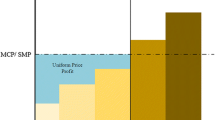Abstract
This paper investigates generators’ strategic behaviors in contract signing in the forward market and power transaction in the electricity spot market. A stochastic equilibrium program with equilibrium constraints (SEPEC) model is proposed to characterize the interaction of generators’ competition in the two markets. The model is an extension of a similar model proposed by Gans et al. (Aust J Manage 23:83–96, 1998) for a duopoly market to an oligopoly market. The main results of the paper concern the structure of a Nash–Cournot equilibrium in the forward-spot market: first, we develop a result on the existence and uniqueness of the equilibrium in the spot market for every demand scenario. Then, we show the monotonicity and convexity of each generator’s dispatch quantity in the spot equilibrium by taking it as a function of the forward contracts. Finally, we establish some sufficient conditions for the existence of a local and global Nash equilibrium in the forward-spot markets. Numerical experiments are carried out to illustrate how the proposed SEPEC model can be used to analyze interactions of the markets.
Similar content being viewed by others
References
Allaz B, Vila J-L (1993) Cournot competition, futures markets and efficiency. J Econ Theory 59: 1–16
Anderson EJ, Philpott AB (2002) Optimal offer construction in electricity markets. Math Oper Res 27: 82–100
Anderson EJ, Xu H (2005) Supply function equilibrium in electricity spot markets with contracts and price caps. J Optim Theory Appl 124: 257–283
Anderson EJ, Xu H (2006) Optimal supply function in electricity markets with option contracts and non-smooth costs. Math Methods Oper Res 63: 387–411
Bushnell J (2007) Oligopoly equilibria in electricity contract markets. J Regulat Econ 32: 225–245
Clarke FH (1983) Optimization and nonsmooth analysis. Wiley, New York
DeMiguel V, Xu H (2008) A stochastic multiple leader Stackelberg model: analysis, computation, and application. Oper Res (to appear)
DeWolf D, Smeers Y (1997) A stochastic version of a Stackelberg-Nash-Cournot equilibrium model. Manage Sci 43: 190–197
Gans JS, Price D, Woods K (1998) Contracts and electricity pool prices. Aust J Manage 23: 83–96
Green RJ (1999) The electricity contract market in England and Wales. J Ind Econ 47: 107–124
Green RJ, Newbery DM (1992) Competition in the British electricity spot market. J Polit Econ 100: 929–953
Gürkan G, Özge AY, Robinson SM (1999) Sample-path solution of stochastic variational inequalities. Math Program 84: 313–333
Holmberg P (2008) Unique supply function equilibrium with capacity constraints. Energy Econ 30: 148–172
Hu X, Ralph D (2007) Using EPECs to model bilevel games in restructured electricity markets with locational prices. Oper Res 55: 809–827
Klemperer PD, Meyer MA (1989) Supply function equilibria in oligopoly under uncertainty. Econometrica 57: 1243–1277
Newbery DM (1998) Competition, contracts and entry in the electricity spot market. RAND J Econ 29: 726–749
Onofri L (2005) Electricity market restructuring and energy contracts: a critical note on the EU commissions NEA decision. Eur J Law Econ 20: 71–85
Pang JS, Fukushima M (2005) Quasi-variational inequalities, generalized Nash equilibria, and multi-leader-follower games. Comput Manage Sci 2: 21–56
Powell A (1993) Trading forward in an imperfect market: the case of electricity in Britain. Econ J 103: 444–453
Robinson SM (1996) Analysis of sample-path optimization. Math Oper Res 21: 513–528
Rosen JB (1965) Existence and uniqueness of equilibrium points for concave N-person games. Econometrica 33: 520–534
Rudkevich A (2005) On the supply function equilibrium and its applications in electricity markets. Decis Support Syst 40: 409–425
Ruszczyński A, Shapiro A (2003) Optimality conditions and duality in stochastic programming. In: Ruszczyński A, Shapiro A (eds) Stochastic programming, handbooks in OR & MS, vol 10. North-Holland Publishing Company, Amsterdam, pp 141–211
Shanbhag U (2005) Decomposition and sampling methods for stochastic equilibrium problems. PhD thesis, Stanford University
Shapiro A, Xu H (2005) Stochastic mathematical programs with equilibrium constraints, modeling and sample average approximation. Optimization (to appear)
Sherali HD (1984) A multiple leader Stackelberg model and analysis. Oper Res 32: 390–405
Sherali HD, Soyster AL, Murphy FH (1983) Stackelberg–Nash–Cournot equilibria: characterizations and computations. Oper Res 31: 253–276
Su C-L (2007) Analysis on the forward market equilibrium model. Oper Res Lett 35: 74–82
von der Fehr N-HM, Harbord D (1992) Long-term contracts and imperfectly competitive spot markets: a study of the UK electricity industry, Memorandum no 14, Department of Economics, University of Oslo
Willems B (2005) Cournot competition, financial option markets and efficiency, CSEM working paper
Xu H (2005) An MPCC approach for stochastic Stackelberg–Nash–Cournot equilibrium. Optimization 54: 27–57
Xu H, Meng F (2007) Convergence analysis of sample average approximation methods for a class of stochastic mathematical programs with equality constraints. Math Oper Res 32: 648–668
Yao J, Oren SS, Adler I (2007) Two-settlement electricity markets with price caps and Cournot generation firms. Eur J Oper Res 181: 1279–1296
Yuan X, Tarafdar E (1996) Non-compact pareto equilibria for multiobjective games. J Math Anal Appl 204: 156–163
Author information
Authors and Affiliations
Corresponding author
Rights and permissions
About this article
Cite this article
Zhang, D., Xu, H. & Wu, Y. A two stage stochastic equilibrium model for electricity markets with two way contracts. Math Meth Oper Res 71, 1–45 (2010). https://doi.org/10.1007/s00186-009-0283-8
Received:
Accepted:
Published:
Issue Date:
DOI: https://doi.org/10.1007/s00186-009-0283-8




